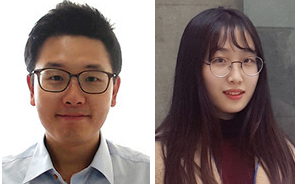Notice
Ajou Univ. News
NEW Prof. Shim Tae-soup’s team develops stimuli-responsive hydrogels
- 2021-01-26
- 8699

Prof. Shim Tae-soup (left) and Kim Min-a (right)
A team of Ajou researchers led by Prof. Shim Tae-soup (Dept. of Chemical Engineering and Dept. of Energy Systems Research) has developed stimulus-responsive hydrogel structures whose surfaces can be controlled at the micrometer level.
The team’s work on generating crease patterns using stimulus-responsive hydrogels was entitled, “Stepwise Evolution of Crease Patterns on Stimuli-Responsive Hydrogels for the Production of Long-Range Ordered Structures,” and published as the featured article in the December issue of Advanced Materials Interfaces, an international journal on cutting-edge materials. Kim Min-a, a master’s candidate in the Department of Energy Systems Research, also participated as the first author.
Crease-prone soft matter can change form easily when thermal energy is applied. Much applied research has been conducted to utilize its pliable physico-chemical properties and microstructures through application of a variety of external stimuli.
Surface creases found on organisms, including fingerprints and palm prints, have especially garnered attention for their potential to increase the surface areas of industrial materials and for their superior fluid and elastic properties. Attempts have been made to simulate these creases in engineering. The mechanisms for forming such creases, however, occur arbitrarily without seeming patterns, frustrating researchers’ repeated attempts to create uniform and ordered two-dimensional crease structures.
Prof. Shim’s team successfully created micro-level anisotropic creases on the surfaces of hydrogel films utilizing the reaction-diffusion system and the viscoelasticity of soft matter. As a result, the hydrogel films expanded in response to pH variations, with surface creases forming hexagonal or rectangular structures step by step.
Furthermore, the team found that yeast cells cultured on these crease structures were aligned with reversibility, empirically demonstrating that the crease patterns are capable of aligning themselves through the mechanism of surface topology without undergoing chemical reactions with biomaterials.
Prof. Shim explained: “The new crease formation mechanism we have discovered, by controlling the structures of polymer films step by step using their anisotropic creases, can be applied to a wide range of materials and stimuli. It can also be used to help develop platforms for inducing the growth of various biomaterials and analyzing cells.”
The study was made possible with support from the National Research Foundation of Korea’s basic research program.
 아주대학교 국제대학원
아주대학교 국제대학원